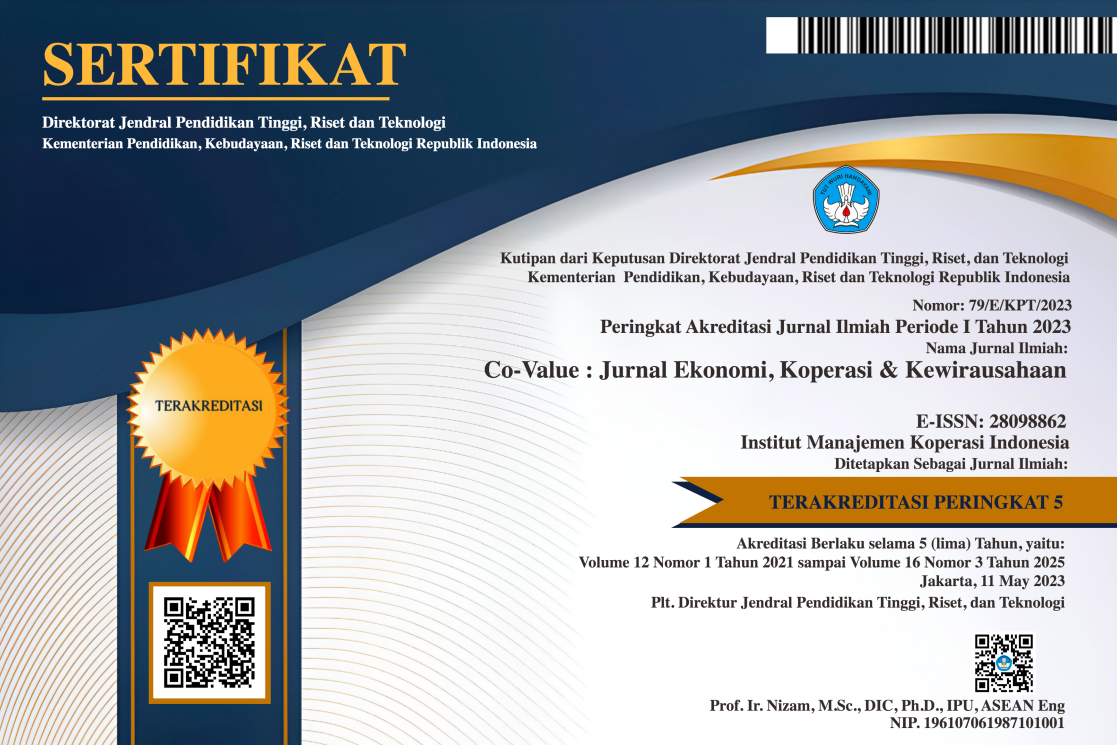Patisserie Business Development to Support the Quality of Tourist Destinations: Case Study of Greater Bandung
Keywords:
patisserie businesses, culinary tourism, greater Bandung, tourist destinations, qualitative researchAbstract
This study employs a qualitative research approach to investigate the development of patisserie businesses in Greater Bandung and their contributions to enhancing the quality of tourist destinations. By utilizing a descriptive case study design, the research incorporates direct observations of selected patisseries and secondary data from government tourism reports, academic literature, and online reviews. Key focus elements include location accessibility, interior ambiance, product variety, service quality, and tourist engagement. Direct observations provide insights into business operations and customer interactions, while secondary data contextualizes these findings within broader tourism trends. The data analysis employs descriptive and content analysis techniques to identify themes and relationships between patisserie development and tourism growth. Triangulation of data sources enhances the validity and reliability of the findings. Ethical considerations are minimal, as observations occur in public spaces, with transparency maintained regarding the observation process. This methodological framework offers a comprehensive examination of the role of patisserie businesses in Greater Bandung, highlighting their integration into the local tourism landscape and their significant contributions to improving the overall tourist experience. The results underscore the importance of culinary tourism in enhancing the attractiveness of destinations, providing valuable insights for stakeholders aiming to optimize their culinary offerings within sustainable tourism practices.
References
Adamov, T., Ciolac, R., Iancu, T., Brad, I., Peț, E., Popescu, G., & Șmuleac, L. (2020). Sustainability of Agritourism Activity. Initiatives and Challenges in Romanian Mountain Rural Regions. Sustainability, 12(6), 2502. https://doi.org/10.3390/su12062502
Alonso, A. D., Kok, S., & O’Brien, S. (2018). Sustainable culinary tourism and Cevicherías: a stakeholder and social practice approach. Journal of Sustainable Tourism, 26(5), 812–831. https://doi.org/10.1080/09669582.2017.1414224
Chen, C. M., Lee, H. T., Chen, S. H., & Huang, T. H. (2011). Tourist behavioural intentions in relation to service quality and customer satisfaction in Kinmen National Park, Taiwan. International Journal of Tourism Research, 13(5), 416–432. https://doi.org/10.1002/jtr.810
Cordova-Buiza, F., Gabriel-Campos, E., Castaño-Prieto, L., & García-García, L. (2021). The Gastronomic Experience: Motivation and Satisfaction of the Gastronomic Tourist—The Case of Puno City (Peru). Sustainability, 13(16), 9170. https://doi.org/10.3390/su13169170
Creswell, W. J., & Creswell, J. D. (2018). Research Design: Qualitative, Quantitative and Mixed Methods Approaches (5th ed.). Sage Publications Inc.
Damayanti, M., Tyas, W. P., & Ningtyas, L. C. P. (2022). Community based integrated sustainable waste management in Lerep tourism village. IOP Conference Series: Earth and Environmental Science, 1098(1), 012051. https://doi.org/10.1088/1755-1315/1098/1/012051
Djatmiko, D. N., & Handayati, Y. (2023). Quality Improvement to Enhance Customer Satisfaction Using Lean Six Sigma (Case Study: XYZ Restaurant). International Journal of Current Science Research and Review, 06(02). https://doi.org/10.47191/ijcsrr/V6-i2-64
Februadi, A., Wibisono, N., & Purnamasari, D. (2019). Bandung’s Image as a Tourist Destination: An Application of Quantitative and Qualitative Approach. International Journal of Applied Business Research, 1(01). https://doi.org/10.35313/ijabr.v1i01.41
Fusté-Forné, F. (2020). What do New Zealand newspapers say about food tourism? Tourism and Hospitality Research, 20(1), 82–92. https://doi.org/10.1177/1467358418810916
Ghanem, M. S. (2019). The Behavioral Intention of Tourists toward Local Foods: An Applied Research on the Local Foods Served in Egyptian Siwa Oasis. Journal of Service Science and Management, 12(06), 714–741. https://doi.org/10.4236/jssm.2019.126049
Hanan, H., & Hemanto, D. (2020). From clothing to culinary industries: creativity in the making of place. Creative Industries Journal, 13(2), 117–136. https://doi.org/10.1080/17510694.2019.1673121
Hełdak, M., Kurt Konakoğlu, S. S., Kurtyka-Marcak, I., Raszka, B., & Kurdoğlu, B. Ç. (2020). Visitors’ Perceptions towards Traditional and Regional Products in Trabzon (Turkey) and Podhale (Poland). Sustainability, 12(6), 2362. https://doi.org/10.3390/su12062362
Hoang, T. D. T. (2023). Examination of Tourists’ Culinary Experience: Revisiting the Experience Economy in the Case of Hue Cuisine. Journal of Tourism and Services, 14(27), 249–264. https://doi.org/10.29036/jots.v14i27.641
Hussein, A. S., Rupianti, R., Khairunisa, N., & Humaira, K. F. (2022). Authenticity and Experience Quality Effect Customer Loyalty of Thematic Restaurants and Demography as Moderation. Journal of Business and Management Review, 3(11), 789–811. https://doi.org/10.47153/jbmr311.5302022
Jalis, M. H., Che, D., & Markwell, K. (2014). Utilising Local Cuisine to Market Malaysia as a Tourist Destination. Procedia - Social and Behavioral Sciences, 144, 102–110. https://doi.org/10.1016/j.sbspro.2014.07.278
Juliansyah, A. F., Putri, A. E., Suryadana, M. L., Endyana, C., & Wardhana, A. K. (2021). Global Muslim Response to Bandung Halal Tourism Branding. International Journal of Applied Sciences in Tourism and Events, 5(2), 197–206. https://doi.org/10.31940/ijaste.v5i2.197-206
Kristanti, M., Jokom, R., Wijaya, S., & Widjaja, D. C. (2018). Culinary Experience Towards Behavioral Of Domestic Tourists in Solo and Bandung, Indonesia. KINERJA, 22(2), 186–199. https://doi.org/10.24002/kinerja.v22i2.1813
Leković, M., Pantić, N., Stanišić, T., & Lazarević, S. (2023). A Contemporary Bibliometric Analysis Of Culinary Tourism Literature. Ekonomika Poljoprivrede, 70(4), 1101–1122. https://doi.org/10.59267/ekoPolj23041101L
Lin, M.-P., Marine-Roig, E., & Llonch-Molina, N. (2021). Gastronomy as a Sign of the Identity and Cultural Heritage of Tourist Destinations: A Bibliometric Analysis 2001–2020. Sustainability, 13(22), 12531. https://doi.org/10.3390/su132212531
Ottenbacher, M. C., & Harrington, R. J. (2013). A Case Study of a Culinary Tourism Campaign in Germany. Journal of Hospitality & Tourism Research, 37(1), 3–28. https://doi.org/10.1177/1096348011413593
Parhan, M., Rindu Fajar Islamy, M., Budiyanti, N., Hari Nugraha, R., Eka Subakti, G., & Fuaddin, A. (2021). The Opportunities And Challenges Halal Tourism In Bandung-Indonesia Regency. Jurnal IPTA, 9(1), 81. https://doi.org/10.24843/IPTA.2021.v09.i01.p08
Peštek, A., & Činjarević, M. (2014). Tourist perceived image of local cuisine: the case of Bosnian food culture. British Food Journal, 116(11), 1821–1838. https://doi.org/10.1108/BFJ-01-2014-0046
Rahmiati, F., Othman, N. A., Bakri, M. H., Ismail, Y., & Amin, G. (2020). Tourism Service Quality and Tourism Product Availability on the Loyalty of International Tourists. The Journal of Asian Finance, Economics and Business, 7(12), 959–968. https://doi.org/10.13106/jafeb.2020.vol7.no12.959
Robinson, R. N. S., Getz, D., & Dolnicar, S. (2018). Food tourism subsegments: A data‐driven analysis. International Journal of Tourism Research, 20(3), 367–377. https://doi.org/10.1002/jtr.2188
Rubish, M., Choriy, M., & Zelenska, L. (2020). GASTRONOMIC TOURISM AS A MEANS OF ACTIVATION TOURIST DESTINATIONS. Scientific Bulletin of Mukachevo State University. Series “Economics,” 1(13), 61–66. https://doi.org/10.31339/2313-8114-2020-1(13)-61-66
Sabil Hussein, A., Rupianti, R., Khairunisa, N., & Fathia Humaira, K. (2022). Authenticity and Experience Quality Effect Customer Loyalty of Thematic Restaurants and Demography as Moderation. Journal of Business and Management Review, 3(11), 789–811. https://doi.org/10.47153/jbmr311.5302022
Schimperna, F., Lombardi, R., & Belyaeva, Z. (2021). Technological transformation, culinary tourism and stakeholder engagement: emerging trends from a systematic literature review. Journal of Place Management and Development, 14(1), 66–80. https://doi.org/10.1108/JPMD-03-2020-0028
Stevanie, Rachmayanti, I., & Wulandari, A. A. A. (2021). West Java culinary tourism center. IOP Conference Series: Earth and Environmental Science, 729(1), 012060. https://doi.org/10.1088/1755-1315/729/1/012060
Stone, M. J., Soulard, J., Migacz, S., & Wolf, E. (2018). Elements of Memorable Food, Drink, and Culinary Tourism Experiences. Journal of Travel Research, 57(8), 1121–1132. https://doi.org/10.1177/0047287517729758
Tarigan, A. K. M., Sagala, S., Samsura, D. A. A., Fiisabiilillah, D. F., Simarmata, H. A., & Nababan, M. (2016). Bandung City, Indonesia. Cities, 50, 100–110. https://doi.org/10.1016/j.cities.2015.09.005
Testa, R. (2019). Culinary tourism experiences in agri-tourism destinations and sustainable consumption-Understanding Italian tourists’ motivations. Sustainability (Switzerland), 11(17). https://doi.org/10.3390/su11174588
Tsai, C. (Simon). (2016). Memorable Tourist Experiences and Place Attachment When Consuming Local Food. International Journal of Tourism Research, 18(6), 536–548. https://doi.org/10.1002/jtr.2070
Vázquez-Martinez, U. J., Sanchís-Pedregosa, C., & Leal-Rodríguez, A. L. (2019). Is Gastronomy A Relevant Factor for Sustainable Tourism? An Empirical Analysis of Spain Country Brand. Sustainability, 11(9), 2696. https://doi.org/10.3390/su11092696
Wahidah, I., & Suherman, D. (2022). Penta Helix Collaboration in Increasing Regional Tourism Competitiveness of Bandung City. Jurnal Manajemen Pelayanan Publik, 6(1), 14. https://doi.org/10.24198/jmpp.v6i1.39986
Woyesa, T. U., & Kumar, S. (2022). “Tree against hunger”: potential of enset-based culinary tourism for sustainable development in rural Ethiopia. Journal of Cultural Heritage Management and Sustainable Development, 12(4), 497–512. https://doi.org/10.1108/JCHMSD-07-2020-0102
Zhang, T., Chen, J., & Hu, B. (2019). Authenticity, Quality, and Loyalty: Local Food and Sustainable Tourism Experience. Sustainability, 11(12), 3437. https://doi.org/10.3390/su11123437






